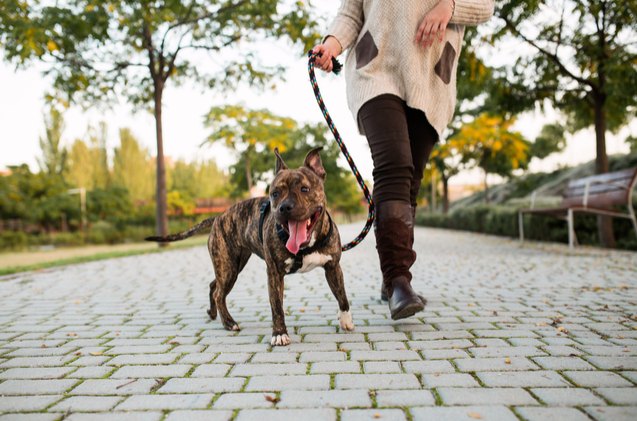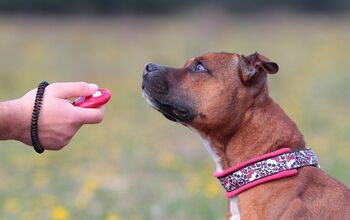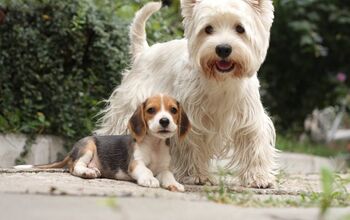On-Leash Dog Greetings: Yea or Nay?

If you’re a dog owner, you’ve probably been there countless times. You’re taking Sadie for a walk down the sidewalk and an oncoming dog, also on leash, is approaching you. What should you do? Should you let Sadie greet the other dog when it reaches you, or is it better to just keep walking?
I recommend you avoid greeting the other dog if:
- you don’t know the dog,
- the other dog, even if you know him, is visibly excited or anxious,
- Sadie has ever shown anxiety or reactivity (aggression) when greeting other dogs, or
- Sadie does not have well-developed leash manners yet, meaning she pulls, lunges, or puts on the breaks at the sight of a dog.
Yes, that’s a lot of ifs. And I’d bet most of us can check off at least one of those boxes.
Related: How Dog-Loving Strangers Ruin Well-Trained Dogs
Have a Sidewalk Strategy
Now I am all for dogs interacting and playing, but the sidewalk just isn’t the place. First of all, the impolite (by doggie standards) face-to-face direct approach of an oncoming dog can cause your pup a great deal of stress as it creeps closer and closer. By the time that unfamiliar dog reaches you, your dog’s anxiety has been building for half a block, so the likelihood of an on-leash confrontation is much higher than if the same two dogs met naturally in an off-leash park, where they could approach more politely from a curved angle without being forced to make direct eye contact.
Additionally, the leashes inhibit both dogs’ greeting body language, making the greeting awkward at best, and at worst, threatening to one or both dogs. If your leashes get tangled or you start to pull your dog back, it only exacerbates this botched greeting and increases the risk.
Related: Should You Bring Your Nervous or Reactive Dog to the Dog Park?
Many owners think that on-leash scuffles start without warning. I’m sure there is a warning, but unless you’re a dog, you’re unlikely to notice it in time to intervene. So if you can’t predict a confrontation, all you can do is avoid putting your dog in that situation.
Leashed walks are a time for your dog to spend with you, not a time for him to be dragging you down the street in search of his next playmate. It’s not fair to expect him to walk politely with you on a loose leash if he is also allowed to drag you towards a dog that is approaching on the sidewalk. If your dog is the playful type, find places that allow him to romp freely: dog parks, doggie daycare facilities, playdates with a friend or neighbor, or supervised play groups at a training or boarding facility.
Pick up the Pace
Once you’ve resolved to put your dog’s safety first and avoid on-leash greetings, how can you avoid other dogs walking down the street? Practice a technique I call “the New Yorker walk.” It has four components:
- Body block. Put yourself between your dog and the oncoming dog, so that your body becomes a barrier that clearly tells your dog he won’t get the chance to meet this new friend.
- Have a short enough leash that your dog can’t dart in front of or behind you. Tie a knot in your leash about mid-way, so you can easily grab the knot when you see another dog coming, giving you the perfect leash length for control.
- Avoid eye contact with the approaching person. Its sounds silly but it works! By not looking at the other person, you’re telling them that you won’t be stopping to say hello. As a result, they will keep walking, too.
- Walk as if you’re on a mission. March, don’t stroll, and your dog will follow.
By channeling your inner New Yorker and making your dog’s safety a priority, you’re ensuring that your dog won’t have negative on-leash experiences that could have a long-term impact.

Kate Naito, CPDT-KA, is a dog trainer at Doggie Academy in Brooklyn, NY, and author of the training book, "BKLN Manners." She draws upon her experience as an educator and dog trainer to apply positive training techniques to a challenging urban environment. Kate is a rescue advocate drawn to special-needs dogs and currently has two Chihuahua mixes, Batman and Beans.
More by Kate Naito























